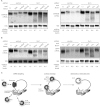A common strategy for host RNA degradation by divergent viruses
- PMID: 22740404
- PMCID: PMC3416159
- DOI: 10.1128/JVI.01230-12
A common strategy for host RNA degradation by divergent viruses
Abstract
Infection with gammaherpesviruses, alphaherpesviruses, and betacoronaviruses can result in widespread mRNA degradation, in each case initiated predominantly by a single viral factor. Although not homologous, these factors exhibit significant mechanistic similarities. In cells, each targets translatable RNAs for cleavage and requires host Xrn1 to complete RNA degradation, although the mechanism of targeting and the position of the primary cleavage differ. Thus, multiple host shutoff factors have converged upon a common mRNA degradation pathway.
Figures




References
Publication types
MeSH terms
Substances
Grants and funding
LinkOut - more resources
Full Text Sources
Other Literature Sources
Medical

